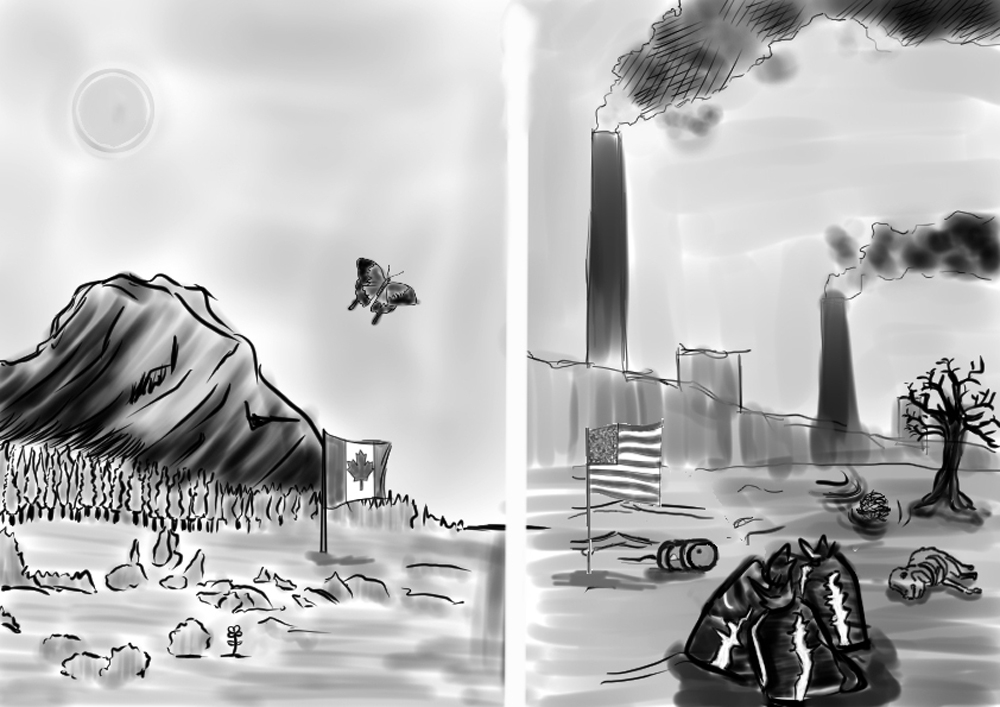Malaika Taylor | Contributor
Featured illustration: Recent interest in migrating to Canada has some questioning its multicultural claim. | Cedric Wong
With Donald Trump’s recent victory as America’s 45th president-elect, the Canadian immigration site found itself flooded with apparent American citizens looking to move, causing the website to temporarily crash. Some were presumably acting out in joking protest while others were seriously anxious about the United States’ future. Regardless, their actions emphasize the reality that Canada is viewed as a safe haven due to its many great qualities. Popular opinion is that Canada has a diverse population of immigrants, assuming it is a multicultural society.
Following the Royal Commission on Bilingual and Bicultural report, then-Prime Minister Pierre Elliott Trudeau introduced Canada’s Multiculturalism Policy in 1971. This policy was put in place to recognize the growing plurality in Canadian society.
Pragmatic as it was, the streets of Canada see celebrations such as the Caribana, and Yonge Street began to diversify to become more than just a singularity of Anglo-Saxon shops. Various cultural restaurants started to take hold in the heart of Toronto’s most important nerve centre next to the Financial District on Bay Street. Since then, there have been revisions made to the policy increasing its compatibility and relevance to the growing Canadian demographic. Looking at the past and present, the face of Canada appears to be ever-changing.
As Canadians, we pride ourselves for being a multicultural mosaic. As York students, we form a community comprised of many different cultural backgrounds, immigration points and religious beliefs. But many people still debate whether or not multiculturalism truly exists on campus and across the country.
This debate seems to stem from uncertainty surrounding how inclusive and tolerant our society really is of all of these different cultures, as well as the spread of the cultures throughout different areas. For instance, if you’ve ever travelled to a small town in Ontario, then you know that the population is much more homogeneous than in a city like Toronto. It seems as though the farther out you venture from the city’s core, the less diverse campuses become.
But even within Toronto, many acknowledge that cliques tend to form, with individuals from the same culture gravitating towards one another. As a result, some people within our society feel marginalized and face the challenges that racism, prejudice and homophobia present for them.
“Despite the fact that Toronto is multicultural, I think there are underlying racial issues. Most people tend to surround themselves with people they know,” says Cornelious Ajibola, a fifth-year psychology student.
Some students agree that the cultural diversity and the many ethnic and religious groups speak to the existence of multiculturalism on campus.
“I think that York overall does a very good job at providing safe spaces around campus for all individuals of different backgrounds,” says Alexandria Magee, second-year psychology student.
“There’s the Scott Religious Centre for people to practice their faith and several culture-based and student-run clubs that have offices in the Student Centre.”
And though there have been changes in policy and legislation that promote diversity and multiculturalism, microaggressions still exist and impact students.
“A truly multicultural society consists of one where everyone’s different backgrounds are integrated and celebrated equally. A truly multicultural society is one where people don’t tell me I have really good English,” says Nancy Truong, a second-year biology student.
However you may feel about past and current policy, as York students, our community consists of a diverse group of people from all around the world. It is our responsibility to ensure that we’re not only present, but that we learn from each others’ rich histories, interact respectfully and advocate for equal representation across the nation.


